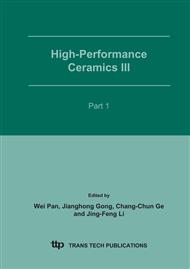p.1563
p.1567
p.1571
p.1575
p.1581
p.1585
p.1589
p.1595
p.1599
Apatite Formation on Porous TCP In Vitro: A Comparative Study between Static and Dynamic RSBF Systems
Abstract:
Porous tricalcium phosphate ceramics were immersed in static and dynamic revised simulated body fluid (RSBF) at 37°C. Morphology, composition and phase of precipitates on TCP were identified by SEM, FTIR and TEM methods. FTIR and TEM results indicated the deposits on the inner pore walls of TCP were OCP, and SEM results implied that the deposited way of precipitates in static system was different from that in dynamic system.
Info:
Periodical:
Pages:
1581-1584
Citation:
Online since:
February 2007
Authors:
Keywords:
Price:
Сopyright:
© 2005 Trans Tech Publications Ltd. All Rights Reserved
Share:
Citation:


